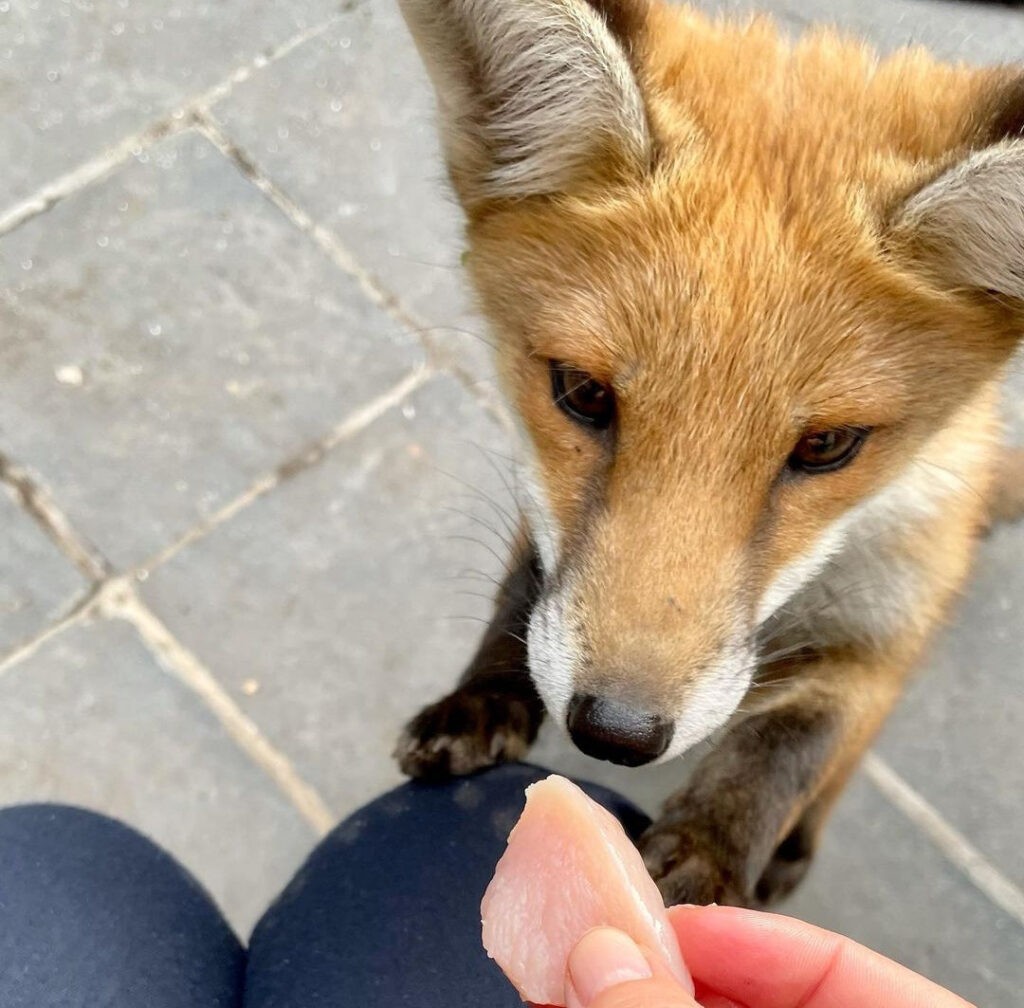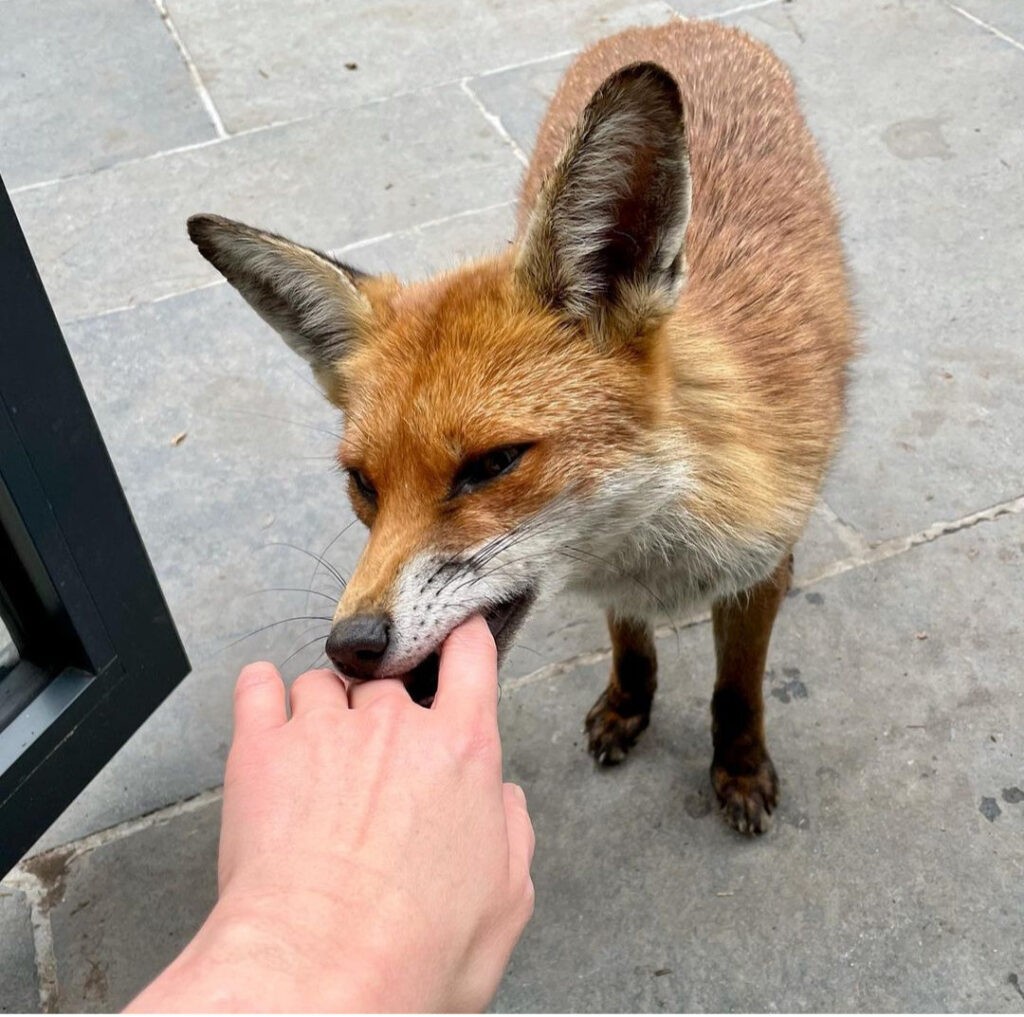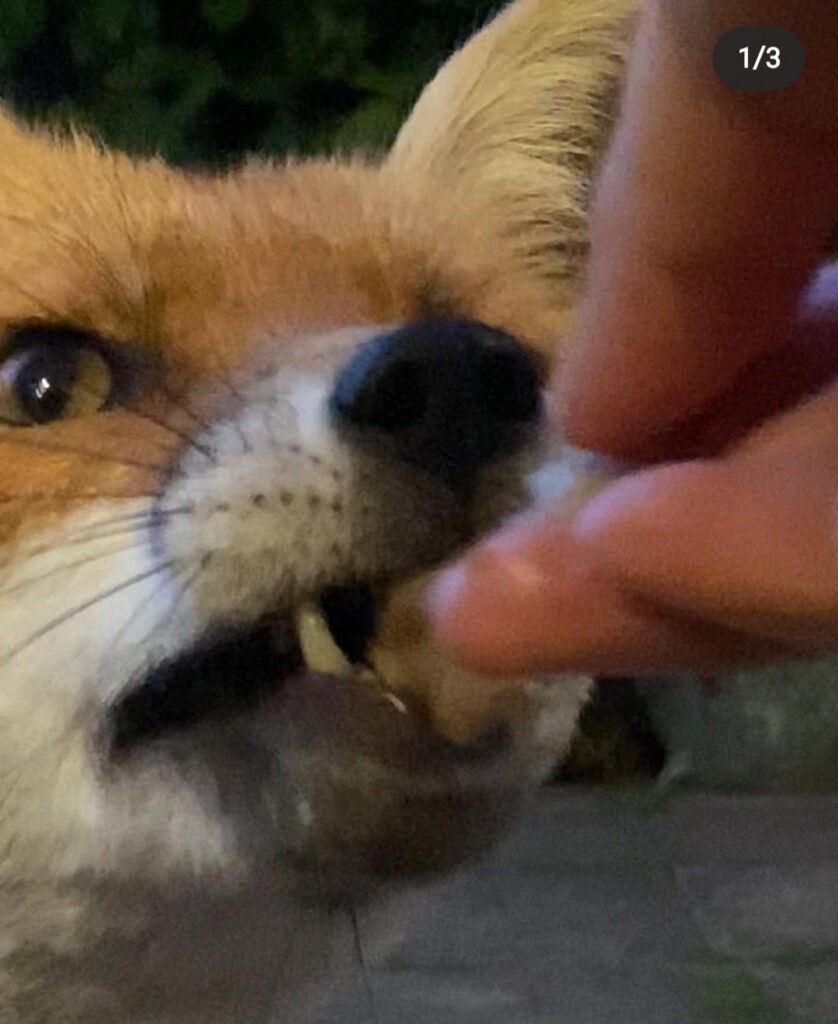At PETS.EDU.VN, we understand the allure of foxes and the desire to interact with these fascinating creatures. The question “Can You Pet Foxes?” is more complex than it seems, with important considerations for both human and animal safety. Let’s explore the world of foxes, their behavior, and responsible ways to appreciate them. For in-depth knowledge and expert advice, PETS.EDU.VN is your go-to resource for all things pet-related and wildlife interactions.
1. The Allure of Foxes: Why Are We Drawn to Them?
Foxes, with their captivating amber eyes, bushy tails, and playful demeanor, hold a special place in our imagination. Their intelligence and adaptability allow them to thrive in diverse environments, from rural landscapes to bustling urban centers. This adaptability makes them more frequently encountered by humans, sparking curiosity and a desire to connect. Foxes often represent cunning, wisdom, and the wild spirit in folklore and popular culture, further fueling our fascination. These creatures are also incredibly expressive, and their interactions with each other and their environment can be mesmerizing to observe. The rise of nature documentaries and social media has also played a significant role in showcasing fox behavior, making them even more relatable and admired. This exposure, while positive in raising awareness, can sometimes lead to misconceptions about their suitability as pets or the safety of direct interaction.
1.1. Foxes in Culture and Media
Foxes have long been figures of fascination in culture and media. From ancient folklore to modern films, they often embody trickery, wisdom, and adaptability. Consider the sly fox in Aesop’s Fables or the mystical kitsune in Japanese mythology. In contemporary media, foxes appear as protagonists, antagonists, and everything in between, further cementing their place in our collective consciousness.
1.2. The Appeal of the Wild
There’s an undeniable allure to wild animals. Their independence, their connection to nature, and their untamed spirit resonate deeply with us. This appeal can be especially strong in urban environments, where encounters with wildlife offer a glimpse of the natural world. Foxes, as adaptable urban dwellers, often become symbols of this wildness, sparking a desire to connect with something beyond our domesticated lives.
2. Understanding Fox Behavior: Wild vs. Domesticated
One of the most critical aspects of answering “Can you pet foxes?” is understanding the fundamental differences between wild and domesticated animals. Domesticated animals, like dogs and cats, have undergone generations of selective breeding to enhance desirable traits such as sociability and obedience. This process fundamentally alters their behavior and makes them more suitable for living alongside humans. Wild animals, on the other hand, retain their natural instincts and behaviors, which are essential for their survival in the wild.
Foxes, even those raised in captivity, retain many of their wild instincts. They are naturally cautious, independent, and prone to unpredictable behavior. While some foxes may become accustomed to human presence, they are not truly domesticated and cannot be expected to behave like a dog or cat. It’s also important to remember that even seemingly friendly foxes may bite or scratch if they feel threatened or stressed.
2.1. The Instincts of a Wild Fox
Wild foxes are driven by instinct, and their behavior is primarily geared towards survival. They are skilled hunters, solitary creatures (except during mating season), and highly territorial. Their natural behaviors include digging dens, marking territory with urine, and caching food for later consumption. These instincts cannot be easily suppressed, even in foxes raised in captivity.
2.2. Domestication: A Long and Complex Process
Domestication is not a simple or quick process. It involves generations of selective breeding to gradually alter an animal’s genetic makeup and behavioral traits. Dogs, for example, are believed to have been domesticated from wolves over thousands of years. Even after generations of breeding, some dog breeds still retain strong instincts related to hunting and herding. Attempting to “domesticate” a fox within a single lifetime is not only unrealistic but also potentially harmful to the animal.
2.3. The Russian Fox Experiment: Insights into Domestication
The Russian Fox Experiment, initiated in the 1950s, provides valuable insights into the process of domestication. Researchers selectively bred silver foxes for tameness, choosing individuals that exhibited the least fear and aggression towards humans. Over generations, these foxes not only became more docile but also developed physical traits associated with domestication, such as floppy ears, curled tails, and altered coat colors. While this experiment demonstrates the potential for domestication, it also highlights the extensive time and resources required to achieve meaningful results. Moreover, the foxes in this experiment were still fundamentally different from fully domesticated animals like dogs, retaining many of their wild instincts and requiring specialized care.
3. The Dangers of Hand-Feeding and Petting Wild Foxes
Hand-feeding and petting wild foxes might seem like a harmless way to connect with nature, but these actions can have serious consequences for both humans and animals. When humans provide food to foxes, they disrupt the animal’s natural foraging behavior and create a dependence on human sources. This can lead to a variety of problems, including:
- Loss of Natural Hunting Skills: Foxes that rely on humans for food may lose their ability to hunt effectively, making them less likely to survive in the wild.
- Overpopulation: Easy access to food can lead to increased breeding rates, resulting in overpopulation and increased competition for resources.
- Changes in Behavior: Hand-fed foxes may become bolder and more aggressive in their pursuit of food, approaching humans more frequently and potentially biting or scratching if they are not fed.
- Spread of Disease: Feeding foxes can concentrate animals in specific areas, increasing the risk of disease transmission among foxes and to other animals, including humans.
- Road Accidents: Foxes that associate humans with food may be more likely to approach roads and vehicles, increasing their risk of being hit by cars.
3.1. Creating Dependency and Altering Natural Behavior
Wild animals need to forage for food to survive. Hand-feeding undermines this essential skill, creating dependency and potentially leading to malnutrition if humans stop providing food.
3.2. Increased Risk of Bites and Scratches
Even foxes that appear friendly can bite or scratch if they feel threatened, startled, or protective of their food. These bites can transmit diseases like rabies.
3.3. Disease Transmission: A Serious Concern
Foxes can carry a variety of diseases, including rabies, mange, and distemper, which can be transmitted to humans and domestic animals. Rabies is a particularly serious concern, as it is fatal if left untreated. While rabies is relatively rare in some regions, it is essential to take precautions to avoid contact with potentially infected animals.
3.4. The Illusion of Control: Why Foxes Can’t Be Tamed
It’s crucial to remember that foxes are wild animals, not pets. While some individuals may become accustomed to human presence, they cannot be truly tamed. Their behavior remains unpredictable, and they retain their natural instincts, which can be incompatible with human interaction.
4. Legal Considerations: Owning a Fox as a Pet
The legality of owning a fox as a pet varies widely depending on the location. Many states and countries have strict regulations regarding the possession of wild animals, including foxes. These laws are in place to protect both the animals and the public. In some areas, it may be illegal to own a fox under any circumstances. In others, permits or licenses may be required, and specific conditions must be met, such as providing adequate housing and veterinary care. Before considering acquiring a fox, it is essential to research and comply with all applicable laws and regulations. Keep in mind that even if it is legal to own a fox, it may not be ethical or responsible. Foxes have specialized needs that are difficult to meet in a domestic environment, and they are not well-suited to being kept as pets.
4.1. State and Local Regulations: A Patchwork of Laws
Laws regarding exotic animal ownership vary greatly from state to state and even from county to county. Some jurisdictions ban the possession of foxes outright, while others require permits and impose strict regulations on housing, care, and disease prevention.
4.2. The Importance of Permits and Licensing
In areas where fox ownership is permitted, obtaining the necessary permits and licenses is crucial. These documents often require proof of adequate housing, veterinary care, and knowledge of fox behavior and management.
4.3. Ethical Considerations: Is It Right to Keep a Wild Animal?
Even if it’s legal to own a fox, it’s important to consider the ethical implications. Foxes are wild animals with complex needs that are difficult to meet in a domestic environment. They require large enclosures, specialized diets, and enrichment activities to prevent boredom and stress.
5. Responsible Ways to Appreciate Foxes: Observation and Conservation
While petting foxes is not recommended, there are many responsible ways to appreciate these fascinating creatures. Observation is a great option, you can observe foxes from a safe distance in their natural habitat. This can be a rewarding experience, allowing you to witness their natural behaviors without interfering with their lives. When observing foxes, it is important to maintain a respectful distance and avoid making any sudden movements or loud noises that might startle them. Using binoculars or a spotting scope can enhance your viewing experience without disturbing the animals. Additionally, supporting fox conservation efforts is essential for protecting these animals and their habitats. This can involve donating to wildlife organizations, volunteering your time for conservation projects, or simply educating others about the importance of fox conservation.
5.1. Wildlife Photography: Capturing Beauty from Afar
Wildlife photography provides a unique opportunity to capture the beauty and essence of foxes without disturbing them. By using telephoto lenses and practicing patience, photographers can document fox behavior and share their images with others, raising awareness and appreciation for these animals.
5.2. Supporting Fox Rescue and Rehabilitation Organizations
Fox rescue and rehabilitation organizations play a vital role in caring for injured, orphaned, or displaced foxes. These organizations provide medical care, food, and shelter to foxes in need, and they often work to release rehabilitated animals back into the wild.
5.3. Creating Fox-Friendly Habitats in Your Backyard
If you live in an area where foxes are present, you can create a fox-friendly habitat in your backyard by providing food, water, and shelter. This can involve planting native vegetation, building a brush pile for shelter, and providing a source of fresh water. However, it is important to avoid hand-feeding foxes, as this can lead to dependency and other problems.
6. Domesticated Foxes: The Reality of Fox Farms
While true domestication of foxes is rare outside of research settings, fox farms exist in some countries, primarily for fur production. These farms raise foxes in captivity, often under inhumane conditions, and slaughter them for their fur. It is crucial to be aware of the ethical implications of supporting the fur industry and to make informed choices about purchasing fur products.
6.1. The Ethical Concerns of Fur Farming
Fur farming raises serious ethical concerns due to the confinement and inhumane treatment of animals. Foxes on fur farms are typically kept in small cages with limited space to move around, and they are often subjected to painful procedures such as tail docking and teeth removal.
6.2. The Impact on Fox Welfare
The conditions on fur farms can have a devastating impact on fox welfare. The animals suffer from stress, boredom, and frustration, and they often exhibit abnormal behaviors such as self-mutilation and pacing.
6.3. Supporting Alternatives to Fur: Cruelty-Free Fashion
Choosing cruelty-free fashion options is a responsible way to avoid supporting the fur industry. Many companies now offer high-quality synthetic and plant-based alternatives to fur that are both stylish and ethical.
7. The Importance of Education and Awareness: Spreading the Word
Education and awareness are crucial for promoting responsible interactions with foxes and for protecting these animals and their habitats. By sharing information about fox behavior, the dangers of hand-feeding, and the importance of conservation, we can help create a more informed and compassionate society. PETS.EDU.VN is committed to providing accurate and up-to-date information about foxes and other animals, and we encourage our readers to share this information with others.
7.1. Debunking Myths and Misconceptions About Foxes
Many myths and misconceptions surround foxes, often portraying them as dangerous or malicious creatures. It is important to debunk these myths and to present a more accurate and balanced view of fox behavior and ecology.
7.2. Promoting Responsible Wildlife Tourism
Wildlife tourism can be a valuable tool for conservation, but it is important to ensure that it is conducted responsibly. This means minimizing disturbance to animals, respecting their natural habitats, and supporting local communities.
7.3. Engaging with Local Communities and Conservation Organizations
Engaging with local communities and conservation organizations is a great way to learn more about fox conservation efforts and to contribute to these efforts. This can involve volunteering your time, donating to organizations, or simply attending community events.
8. Health and Safety Precautions When Encountering Foxes
While it’s best to observe foxes from a distance, knowing how to react safely during an encounter is essential. Maintaining a safe distance, avoiding direct eye contact, and never attempting to feed or approach a fox are vital. If a fox approaches you, remain calm, make yourself appear larger by raising your arms, and speak in a loud, assertive voice. Slowly back away while maintaining eye contact. Report any aggressive or unusual behavior to your local animal control or wildlife authorities immediately. It’s also crucial to keep pets vaccinated against rabies and other diseases and to prevent them from interacting with foxes.
8.1. Recognizing Signs of a Healthy vs. Unhealthy Fox
Knowing the signs of a healthy and unhealthy fox can help you assess the situation during an encounter. Healthy foxes are typically alert, active, and have a sleek coat. Unhealthy foxes may appear lethargic, disoriented, or have visible signs of illness such as mange or open wounds.
8.2. What to Do If You Are Bitten or Scratched by a Fox
If you are bitten or scratched by a fox, it is crucial to seek medical attention immediately. Wash the wound thoroughly with soap and water, and contact your doctor or local health department. They will assess the risk of rabies and determine whether post-exposure prophylaxis is necessary.
8.3. Protecting Your Pets from Foxes
Protecting your pets from foxes is essential, especially if you live in an area where foxes are common. Keep your pets vaccinated against rabies and other diseases, and supervise them when they are outdoors. Avoid leaving pet food outside, as this can attract foxes to your property.
9. Addressing Common Concerns About Foxes
Many people have concerns about foxes, such as their potential impact on pets, gardens, or livestock. Addressing these concerns with accurate information and practical solutions is important. While foxes can sometimes prey on small pets, this is relatively rare, and taking precautions such as keeping pets indoors at night and supervising them when outdoors can minimize the risk. Foxes can also damage gardens by digging or scavenging for food, but this can be prevented by using fencing or repellents.
9.1. Foxes and Pets: Understanding the Risks and Taking Precautions
While foxes are generally not a threat to larger pets, they can prey on small animals such as rabbits, guinea pigs, and chickens. Taking precautions such as keeping pets indoors at night and supervising them when outdoors can minimize the risk.
9.2. Managing Fox Activity in Your Garden
Foxes can sometimes damage gardens by digging or scavenging for food. Using fencing, repellents, and removing potential food sources such as fallen fruit can help manage fox activity in your garden.
9.3. Coexisting Peacefully with Foxes: A Community Approach
Coexisting peacefully with foxes requires a community approach. This involves educating neighbors about responsible interactions with foxes, working together to manage fox populations, and supporting local conservation efforts.
10. The Future of Fox Conservation: Protecting Wild Populations
The future of fox conservation depends on our collective efforts to protect wild populations and their habitats. This involves supporting conservation organizations, promoting responsible wildlife tourism, and advocating for policies that protect foxes and their ecosystems. By working together, we can ensure that foxes continue to thrive in the wild for generations to come. At PETS.EDU.VN, we believe that education and awareness are key to fostering a more compassionate and sustainable relationship with all animals, including foxes.
10.1. Habitat Preservation: Protecting Fox Ecosystems
Habitat preservation is essential for protecting fox populations. This involves conserving forests, grasslands, and other natural habitats, and preventing habitat loss due to development and agriculture.
10.2. Climate Change and Foxes: Addressing the Challenges
Climate change poses a significant threat to fox populations, as it can alter their habitats, disrupt their food sources, and increase the risk of disease. Addressing climate change through reducing greenhouse gas emissions and promoting sustainable practices is crucial for protecting foxes and other wildlife.
10.3. Citizen Science: Contributing to Fox Research
Citizen science initiatives provide opportunities for members of the public to contribute to fox research. This can involve participating in wildlife surveys, reporting fox sightings, and collecting data on fox behavior and ecology.
Understanding fox behavior, respecting their wild nature, and supporting conservation efforts are crucial for coexisting with these fascinating animals. At PETS.EDU.VN, we encourage responsible wildlife interactions and provide resources for learning more about foxes and other species.
For more information, contact us at 789 Paw Lane, Petville, CA 91234, United States. Whatsapp: +1 555-987-6543 or visit our website at PETS.EDU.VN.
This information aims to promote responsible wildlife interactions. PETS.EDU.VN encourages learning about and respecting foxes and other wild species.
FAQ: Can You Pet Foxes?
1. Is it safe to pet a fox?
It is generally not safe to pet a fox, especially a wild one. Foxes are wild animals with unpredictable behavior, and they may bite or scratch if they feel threatened.
2. Can foxes be domesticated?
While some foxes have been selectively bred for tameness in research settings, true domestication is rare, and foxes retain many of their wild instincts.
3. What are the risks of hand-feeding foxes?
Hand-feeding foxes can create dependency, alter their natural behavior, increase the risk of bites and scratches, and contribute to the spread of disease.
4. Is it legal to own a fox as a pet?
The legality of owning a fox as a pet varies widely depending on the location. Many areas have strict regulations regarding the possession of wild animals.
5. How can I appreciate foxes responsibly?
You can appreciate foxes responsibly by observing them from a safe distance, supporting fox rescue and rehabilitation organizations, and creating fox-friendly habitats in your backyard.
6. What should I do if I encounter a fox?
If you encounter a fox, maintain a safe distance, avoid direct eye contact, and never attempt to feed or approach it. If the fox approaches you, remain calm, make yourself appear larger, and slowly back away.
7. What are the signs of a healthy vs. unhealthy fox?
Healthy foxes are typically alert, active, and have a sleek coat. Unhealthy foxes may appear lethargic, disoriented, or have visible signs of illness.
8. What should I do if I am bitten or scratched by a fox?
If you are bitten or scratched by a fox, seek medical attention immediately. Wash the wound thoroughly with soap and water, and contact your doctor or local health department.
9. How can I protect my pets from foxes?
Keep your pets vaccinated against rabies and other diseases, and supervise them when they are outdoors. Avoid leaving pet food outside, as this can attract foxes to your property.
10. How can I support fox conservation efforts?
You can support fox conservation efforts by donating to wildlife organizations, volunteering your time for conservation projects, and educating others about the importance of fox conservation.
Summary Table: Dos and Don’ts When Encountering Foxes
| Category | Do | Don’t |
|---|---|---|
| Observation | Observe from a safe distance with binoculars or a camera. | Approach, feed, or attempt to interact directly with the fox. |
| Safety | Stay calm, make yourself look big, and back away slowly. | Run, make sudden movements, or corner the fox. |
| Health | Report any bites or scratches to a doctor immediately. | Ignore wounds or delay seeking medical attention. |
| Pets | Supervise pets outdoors and keep them vaccinated. | Allow pets to interact freely with foxes. |
| Environment | Support local conservation organizations and habitat preservation. | Disturb or destroy fox habitats. |
| Responsibility | Educate yourself and others about fox behavior and safety. | Spread misinformation or myths about foxes. |
| Legal | Check local regulations regarding fox ownership. | Own a fox illegally or without proper permits. |



This table provides a quick reference guide to help you remember the key points discussed in this article.
By following these guidelines, we can ensure the safety and well-being of both humans and foxes, fostering a more harmonious coexistence between us and these fascinating creatures.
Navigating Fox Encounters: A Detailed Guide
| Scenario | Recommended Action | Why |
|---|---|---|
| Fox Approaches You | Remain calm, make yourself appear larger by raising your arms, and speak in a loud, assertive voice. Slowly back away while maintaining eye contact. | This helps deter the fox without provoking it. Making yourself look bigger can intimidate the fox, while speaking loudly asserts your presence. |
| Fox Shows Aggression | Continue to back away slowly. If the fox attacks, use anything available (e.g., a stick, rock, or your bag) to defend yourself. | Prioritize your safety. Defending yourself can deter the fox and prevent serious injury. Report the incident to local authorities immediately. |
| Fox Appears Injured/Sick | Do not approach the fox. Contact your local animal control or wildlife rescue organization immediately. Provide them with the location of the fox and a description of its condition. | Professional help is needed. Approaching a sick or injured fox can be dangerous, and trained professionals have the expertise and equipment to handle the situation safely and provide the necessary care. |
| Fox Enters Your Property | Remove any potential food sources (e.g., pet food, garbage). Install motion-activated lights and noisemakers to deter the fox. Consider fencing your property to prevent entry. | Prevention is key. Removing food sources reduces the fox’s incentive to visit your property. Lights and noisemakers can scare the fox away, while fencing provides a physical barrier. |
| Fox Has a Den Nearby | Do not disturb the den. Keep pets away from the area. Monitor the situation from a distance. Contact a wildlife professional if you have concerns about the fox’s behavior or safety. | Respect their space. Disturbing a den can stress the foxes and potentially lead to abandonment of their young. Monitoring from a distance allows you to observe their behavior without interfering. |
| Fox is Trapped | Contact your local animal control or wildlife rescue organization immediately. Do not attempt to free the fox yourself, as this can be dangerous. | Professional help is needed. Attempting to free a trapped fox can result in injury to yourself and the animal. Trained professionals have the expertise and equipment to handle the situation safely. |
This detailed table will prepare you for various fox encounters, providing clear steps and explanations to ensure safety and respect for wildlife.
pets.edu.vn also has great articles on “How to identify wild animals,” and “How to protect your property from wildlife.” Check them out and remember to stay safe.
